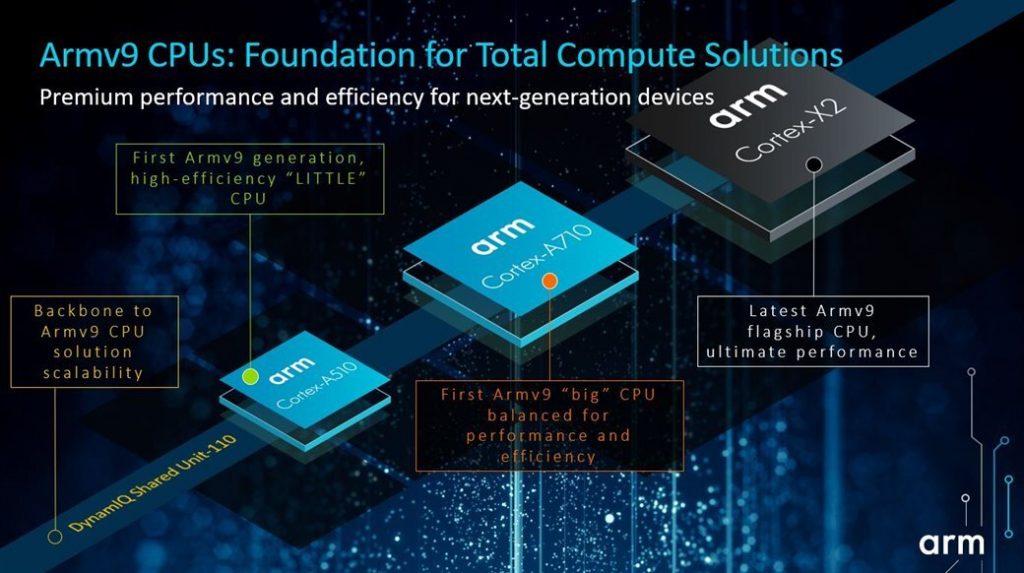Early this year, after nearly a decade since the release of the Armv8, Arm introduced its new Armv9 architecture. This new architecture is in response to the ever-increasing demand for the specialized processing required to keep up with the explosive growth of the Internet of Things, AI applications, and 5G.
Security is the principal focus of the Armv9:
…the Armv9 roadmap introduces the Arm Confidential Compute Architecture (CCA). Confidential computing shields portions of code and data from access or modification while in-use, even from privileged software, by performing computation in a hardware-based secure environment. (Source: Arm)
This means the “commercially sensitive data and code”, in-use, at rest or in transit, will be protected from everything else in the system.
The new Armv9 architecture also address the need to support AI workloads, as AI elements are increasingly part of devices and apps. To handle AI requirements, Arm has joined forces with Fujitsu to develop Scalable Vector Extension technology that supports machine learning and DSP (our old friend!) capabilities for apps like image processing and smart home devices.
processing and smart home devices.
With Armv9, Arm also expects to boost CPU performance, which will be accomplished by deploying Arm’s Total Compute design methodology.
Additionally, Arm is developing several technologies to increase frequency, bandwidth, and cache size, and reduce memory latency to maximize the performance of Armv9-based CPUs.
ZDNet took the occasion of the big Arm announcement to produce an informative article titled “Arm Processors: Everything You Need to Know.” It may not be quite everything you need (or want) to know about Arm, but the piece is detailed (and pretty lengthy: settle in for a good long read).
Some of that read is devoted to Arm’s business model, which is not to build processor components but, rather, to license component design – Arm’s intellectual property – for others to work with. (Critical Link incorporates Arm-based components from makers like Intel and Texas Instruments in some of our SOMs.) There’s also a good explanation of what it means when a device is built around x86 (as in, e.g., “Intel Inside”) vs. when a device is designed around Arm. And if you’re interested in the relationship between Arm and Apple, this may be the article for you. (There’s also a section on the Arm-Nvidia deal, which may or may not happen. Regulators world-wide are looking at that one. Stay tuned!)
Things got going for me when the more technical discussion began.
There’s a good section on the merits of RISC (Reduced Instruction Set Computer) computing – which is where the “r” in “Arm” comes from – vs. CISC (Complex Instruction Set Computers (CISC) when it comes to efficiency and customizability. This section is followed by more discussion of the difference between an Arm processor and an x86 CPU, and an explanation of the difference between an Arm chip and a GPU.
The article then presents a summary of the design classes of Arm processors that are in production today. Critical Link has several offerings that incorporate Cortex-A design, which is considered the “workforce of the Arm family.”
As originally conceived, the client looking to build a system around Cortex-A had a particular application in mind for it, such as a digital audio amplifier, digital video processor, the microcontroller for a fire suppression system, or a sophisticated heart rate monitor. As things turned out, Cortex-A ended up being the heart of two emerging classes of device: single-board computers capable of being programmed for a variety of applications, such as cash register processing; and most importantly of all, smartphones. Importantly, Cortex-A processors include memory management units (MMU) on-chip…The principal tool in Cortex-A’s arsenal is its advanced single-instruction, multiple-data (SIMD) instruction set, code-named NEON, which executes instructions like accessing memory and processing data in parallel over a larger set of vectors. Imagine pulling into a filling station and loading up with enough fuel for 8 or 16 tanks, and you’ll get the basic idea.
I guess that’s why we like it!
There’s also the Cortex-R class, used primarily for “microcontroller applications that require real-time processing,” and the Cortex-M, “a more miniaturized form factor.” Ethos-N processors are deployed for neural network processing; the Ethos-U works as a co-processor, often in conjunction with Cortex-A. Neoverse is for servers and data centers. Secure Core is used in smartcard and embedded security apps.
Our latest SOMs (the MitySOM-AM57F and MitySOM-AM57X) have dual Cortex-M4s on board as part of the TI AM57x processor architecture.
The article continues with a few more technical sections, then concludes with a brief history of Arm processors.
Throughout the article, there are links to a number of different articles/videos you make want to graze through if you have the time and want to learn more. And speaking of learning more, there’s a good summary of the new Armv9 architecture on embedded.com. Happy reading!
